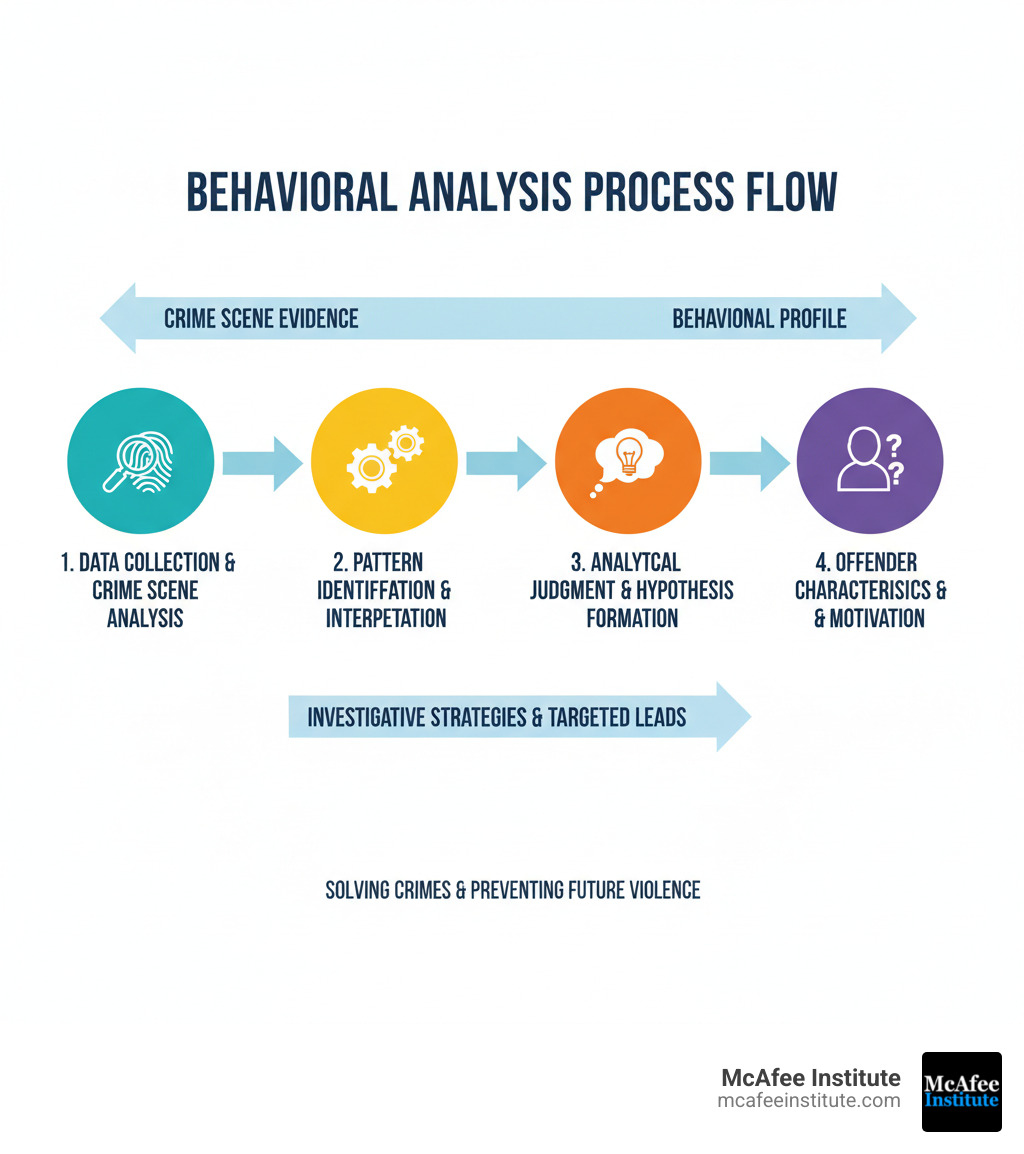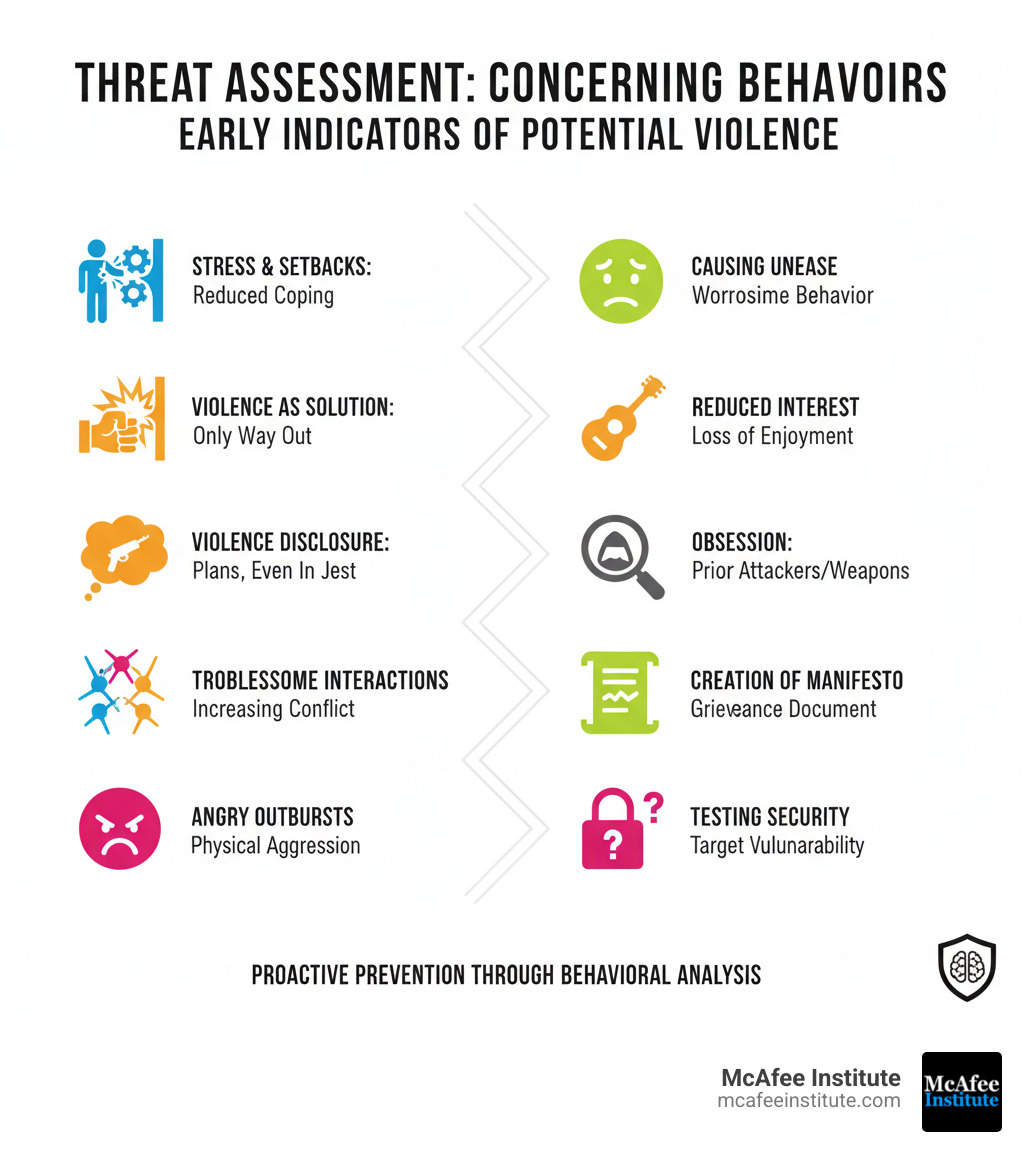Why Law Enforcement Needs Behavioral Analysis
Behavioral analysis in law enforcement is the study of criminal behavior to understand offenders, predict their actions, and aid investigations. It focuses on observable actions—analyzing crime scenes, victim selection, and offender behavior to build effective investigative strategies.
Key applications of behavioral analysis include:
- Criminal Investigative Analysis - Examining crime scenes to understand offender motivation and characteristics
- Interview Strategy Development - Using behavioral principles to conduct effective suspect interviews
- Threat Assessment - Identifying individuals who may pose a risk of violence before they act
- Case Linkage - Connecting seemingly unrelated crimes through behavioral patterns
- Victimology - Understanding victims' lives to reveal how offenders gained access
Unlike Hollywood portrayals, real behavioral analysis combines psychology, criminology, and investigative science with operational law enforcement experience. The FBI's Behavioral Analysis Unit, established in 1972, pioneered this evidence-based approach to help solve violent crimes and protect communities.
The ability to understand why an offender acts, not just what they did, can make the difference in an investigation. Reading the behavioral evidence at a crime scene opens up leads that traditional methods miss.
The process is straightforward: Crime scene evidence reveals behavioral patterns, which analysts interpret to help investigators develop targeted strategies, narrow suspect pools, and prevent future violence.
I'm Joshua McAfee, and I've spent decades building effective law enforcement training systems, from creating Amazon's Loss Prevention program to founding McAfee Institute. I've seen how mastering behavioral analysis in law enforcement transforms investigators, and I've built certifications that reflect that reality.

The Evolution of Criminal Profiling: From BSU to the Modern BAU
The story of behavioral analysis in law enforcement didn't start with the FBI. Its modern origins can be traced to cases like New York City's "Mad Bomber" in the 1950s. After years of dead ends, investigators turned to psychiatrist Dr. James Brussel. He created a startlingly accurate profile of the offender, George Metesky, based on crime scene evidence and letters, proving that criminal behavior was readable.
This case became a blueprint.

Inspired by such cases, the FBI established the Behavioral Science Unit (BSU) in 1972. The original members were investigators who believed science could sharpen their instincts. By 1985, this work was formalized into the National Center for the Analysis of Violent Crime (NCAVC), making behavioral analysis a national resource.
Today, the work continues under the FBI's Behavioral Analysis Unit (BAU), part of the Critical Incident Response Group (CIRG). This structure embeds analysts in critical incident response, providing real-time support during active investigations, hostage situations, and terrorism threats.
The Structure of the FBI's Behavioral Analysis Unit (BAU)
The modern BAU is not a single team but five separate units, each with a specific focus:
BAU 1 handles counterterrorism, arson, and bombing. These analysts understand the behavioral signatures of individuals and groups planning large-scale destruction.
BAU 2 focuses on threats, financial crime, and public corruption. This unit applies behavioral analysis to stalking, white-collar crime, and corruption cases.
BAU 3 is dedicated to crimes against children, including abductions, sexual exploitation, and trafficking.
BAU 4 tackles crimes against adults, such as serial murders and sexual assaults. It also manages the Violent Criminal Apprehension Program (ViCAP), a national database for linking cases.
BAU 5 is focused on research, strategy, and instruction. This unit develops new methodologies and trains the next generation of analysts, ensuring the field continues to evolve.
Together, these units represent the most advanced application of behavioral analysis in law enforcement in the world. More information about the FBI's Critical Incident Response Group is available for those who want to understand how the BAU fits into the FBI's broader mission.
The evolution from Dr. Brussel's early profile to today's sophisticated BAU structure shows how far the field has come by combining behavioral science with investigative discipline.
The Core of Behavioral Analysis in Law Enforcement: Principles and Techniques
Behavioral analysis in law enforcement uses core principles to translate crime scene evidence into actionable leads. It's a systematic application of psychological and criminological science to understand the "why" behind a crime.

Criminal Investigative Analysis (CIA) is a foundational technique. It examines a crime's facts while interpreting the offender's behavior, based on the principle that actions reflect thought processes and personality.
Victimology is also critical. Studying a victim's routines, relationships, and vulnerabilities can reveal how an offender gained access and why that person was targeted. Understanding the victim often illuminates the offender.
Analysts also distinguish between an offender's Modus Operandi (MO) and their Signature. The MO consists of the practical, evolving actions needed to commit the crime. The Signature, however, is composed of unnecessary behaviors that fulfill an offender's psychological needs. Signatures are consistent across crimes because they stem from deep-seated compulsions.
Crime scene manipulation, such as staging a homicide to look like a suicide or masking evidence, often creates more clues for investigators. Moving a body is a particularly high-risk act that strongly suggests the offender has a personal connection to the victim or the primary crime scene and fears being identified.
Understanding Offender Characteristics: Organized vs. Disorganized
One useful framework categorizes offenders as "organized" or "disorganized." While most offenders are a mix, these archetypes provide a starting point for investigative strategies.
Organized offenders are often intelligent and socially competent. Their crimes are premeditated, targeting strangers and showing control over the scene. They may move the body to avoid detection and often follow the case in the media.
Disorganized offenders generally have lower intelligence and poor social skills. Their crimes are impulsive and chaotic, often occurring near their home. The victim may be an acquaintance, and the crime scene is messy, with the body typically left in place.
This framework helps investigators narrow suspect pools and prioritize leads based on what the crime scene reveals about the offender's psychological state.
The Role of Behavioral Analysis in Law Enforcement Interrogations
Behavioral analysis also shapes interview and interrogation strategies. The goal is to understand the person's motivations, psychological makeup, and vulnerabilities to guide questioning.
Techniques like Behavioral Evidence Analysis (BEA) help assess deception and analyze cognitive patterns. Understanding an offender's core motivation is key to framing questions that elicit truthful information.
Ethical considerations are paramount. Coercion and psychological manipulation can lead to false confessions, so modern training emphasizes evidence-based practices that protect individual rights while pursuing justice. Effective interrogations yield truthful, admissible information while respecting the rights of everyone involved.
For those documenting these processes, clear reporting is essential. We recommend reviewing resources on How to Write an Investigation Report: A Step-by-Step Guide to ensure findings are properly communicated.
Practical Applications and Key Support Programs
The real power of behavioral analysis in law enforcement shows up when it is applied to active cases. It's used to solve crimes, identify unknown suspects, and stop violence before it happens.

When traditional leads run dry, behavioral analysis offers a new direction. By analyzing an offender's thinking and methods, analysts can provide recommendations on leads to prioritize, interview strategies to employ, and profiles of unknown offenders.
Key applications include linkage analysis to connect crimes across jurisdictions and threat assessment to stop violence proactively.
Key Programs Supporting Behavioral Analysis
Three major programs form the backbone of this support for U.S. law enforcement.
The Violent Criminal Apprehension Program (ViCAP), a national database since 1985, helps link homicides, sexual assaults, and missing persons cases across jurisdictions by identifying behavioral patterns in crimes.
The Behavioral Threat Assessment Center (BTAC) is a multiagency task force focused on preventing terrorism and targeted violence by identifying threats before they materialize.
The Threat Assessment and Threat Management (TATM) Initiative fosters collaboration between law enforcement, mental health professionals, and educators to share information and prevent violence at a community level. The FBI's Making Prevention a Reality FBI Report details how these approaches work.
From Reactive to Proactive: Threat Assessment
A major evolution in behavioral analysis in law enforcement is the shift toward prevention. Research shows that individuals who commit mass violence rarely "snap" but instead follow a pathway of planning and preparation, often displaying warning signs.
Studies of active shooters and terrorists reveal consistent pre-attack behaviors that concern those around them. These concerning behaviors can include:
- A reduced ability to cope with stress
- Viewing violence as a solution to problems
- Making disclosures about violent plans
- Detailed fantasies about violence
- Escalating angry outbursts or aggression
- Obsessive interest in previous attackers or weapons
- Creating a manifesto or grievance document
- Acquiring weapons or conducting surveillance on a target

While no single behavior is a definitive predictor, a cluster of these indicators signals a need for intervention. This proactive approach saves lives. Professionals can specialize in this area by becoming a Certified Workplace Violence & Threat Specialist. This work often involves analyzing public information, a skill covered in our guide on Understanding OSINT: A Comprehensive Guide.
The goal is to identify warning signs early enough to intervene and prevent violence altogether.
Limitations, Criticisms, and the Future
While behavioral analysis in law enforcement is a valuable tool, it's important to understand its limitations and criticisms.
A primary criticism concerns scientific validity. Some researchers question whether profiling relies more on intuition than on empirically proven science, sparking legitimate debates about methodology. For an academic perspective, "Offender Profiling and Expert Testimony: Scientifically Valid or Glorified Results?" offers a thorough examination.
Confirmation bias is another pitfall, where investigators may unconsciously seek evidence that confirms a pre-existing profile while overlooking contradictory information. Rigorous training and objectivity are essential to counter this.
The "CSI effect" from popular media also creates unrealistic expectations, portraying profiling as a psychic ability rather than a methodical investigative support tool. Real analysis provides leads; it is not a crystal ball.
Practitioners often argue that many critical studies lack external validity, failing to replicate the complex, real-world conditions of an actual investigation. The field is constantly working to integrate more scientific rigor and data-driven approaches.
The future of behavioral analysis involves integrating technology like artificial intelligence and advanced data analytics. These tools can process vast amounts of information to spot patterns and link cases, augmenting the work of human analysts. To learn more, see How AI is Transforming the Future of Investigations.
Technology improves, but does not replace, the human understanding of psychology and motivation. The best approach combines AI's pattern recognition with the contextual judgment of a trained analyst. Behavioral analysis will never be perfect, but like any forensic tool, its value lies in being part of a comprehensive investigative strategy.
Building a Career in Behavioral Analysis
A career in behavioral analysis in law enforcement is a rewarding path for those interested in the intersection of psychology and criminal justice. It's a challenging field that requires dedication and specialized training.
A strong academic foundation is essential, typically starting with a bachelor's degree in psychology, criminology, or a related field. Many roles, especially at the federal level, require a master's degree or even a doctorate in a behavioral science.
One common pathway is through law enforcement experience. Working as an officer or detective provides invaluable first-hand knowledge of crime scenes, investigations, and offender behavior.
To become an FBI Special Agent and potentially join the BAU, candidates must meet strict requirements for age, citizenship, and professional experience. The competition is intense.
Civilian analyst roles are also available in federal, state, and local agencies. These positions typically require advanced degrees in behavioral science but not law enforcement credentials. Other agencies like the ATF, as well as state and large city police departments, also employ behavioral analysts.
At McAfee Institute, we bridge the gap between theory and practice with government-recognized professional certification programs. Our courses are designed by experts with real-world law enforcement and intelligence experience.
Our certifications offer lifetime access to all materials, live instructor support, and free updates for life—with no annual renewals or hidden fees. We believe your investment in education should last your entire career.
Whether you're an experienced professional or new to the field, our accredited training can advance your career. We encourage you to Explore Board Certification Programs to see how we can help you achieve your goals in this vital discipline.
Frequently Asked Questions about Behavioral Analysis in Law Enforcement
What is the difference between a criminal profiler and a behavioral analyst?
While often used interchangeably, "criminal profiling" and "behavioral analysis" have distinct meanings. "Criminal profiling" traditionally refers to the single technique of inferring offender characteristics from a crime scene.
Today, professionals prefer the broader term "behavioral analysis." This reflects a more comprehensive, scientific discipline that includes threat assessment, interview strategies, and case linkage. In short, criminal profiling is one tool within the larger toolkit of behavioral analysis.
How accurate is behavioral analysis in solving crimes?
Behavioral analysis is a powerful investigative support tool, not a crystal ball. Its accuracy lies in its ability to narrow suspect pools, provide insight into offender motivation, and guide investigative strategies. It does not definitively identify a single perpetrator on its own.
While academic studies on its validity are mixed, practitioners note that lab settings don't replicate the complexity of real-world cases. It is most effective when combined with traditional forensics, detective work, and other forms of evidence, as it provides crucial psychological context that other methods can't.
Can you become a behavioral analyst without being in the FBI?
Yes. While the FBI's Behavioral Analysis Unit is well-known, many other career paths exist.
- State and local law enforcement agencies increasingly have their own behavioral analysis or criminal intelligence units.
- Other federal agencies, like the Bureau of Alcohol, Tobacco, Firearms and Explosives (ATF), and various military branches also employ behavioral analysts.
- Civilian roles are available in government, academia, and private consulting, focusing on research, threat assessment, and forensic psychology.
- The private sector also hires threat assessment specialists to prevent workplace violence and protect assets.
These roles typically require advanced degrees and specialized certifications, such as those offered at McAfee Institute, which are recognized by employers across both public and private sectors.
Conclusion: The Enduring Value of Understanding Criminal Behavior
From early profiles to today's sophisticated multidisciplinary teams, behavioral analysis in law enforcement has fundamentally changed how we approach criminal investigations and public safety. It's about understanding the why behind criminal acts, reading behavioral evidence, and using that knowledge to prevent violence before it occurs.
This approach uncovers leads that traditional methods might miss. We've explored its evolution, core techniques, and key support programs like ViCAP, while also acknowledging its limitations. The goal is to use it as an effective, evidence-based tool.
Behavioral analysis in law enforcement is a powerful tool that amplifies, not replaces, traditional detective work. Success requires rigorous training, ethical practice, and a commitment to continuous learning. Its enduring value lies in empowering investigators to identify threats, apprehend dangerous offenders, and create safer communities.
The need for skilled analysts has never been greater. At McAfee Institute, we meet this need with certification programs designed by real-world experts, offering lifetime access and live instructor support.
If you are ready to advance your skills in this vital field and make a tangible difference, we invite you to Advance your career with a Professional Criminal Investigator Certification.










Share:
COOL Certs: Your Path to Civilian Career Success
Criminal Profiling 101: Your Guide to Their Daily Grind